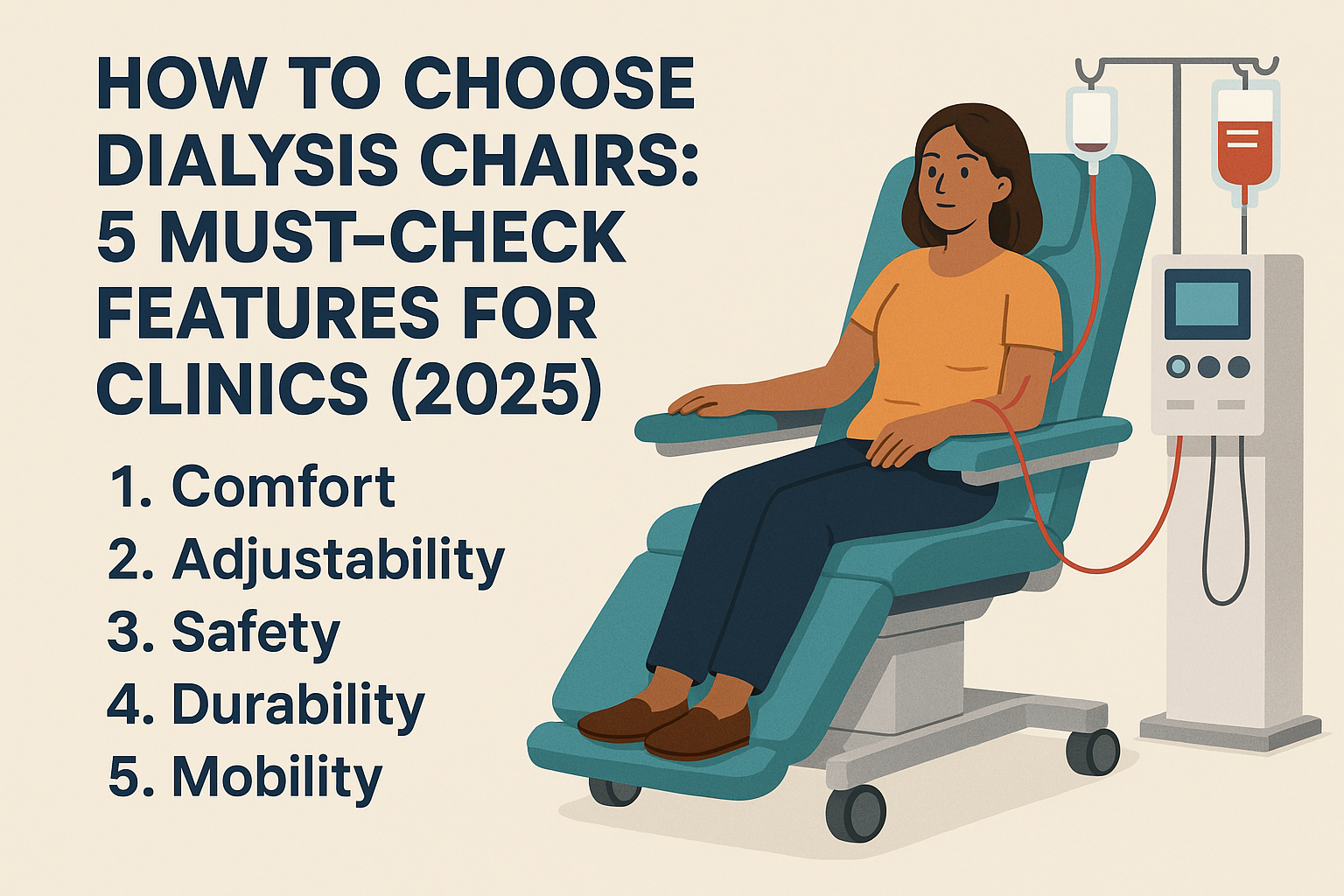How to Choose Dialysis Chairs: 5 Must-Check Features for Clinics (2025)

Choosing the Right Dialysis Chair? Here’s What to Look For
Let’s face it - dialysis chairs aren’t just another piece of furniture. For your patients, it’s where they spend hours at a time, multiple days a week. For your staff, it’s a tool that needs to work with them, not against them. So if you're shopping around this year and wondering how to choose dialysis chairs that truly meet both comfort and clinical needs, you’re in the right place. This guide breaks it down in a no-fluff, practical way to help you make the right call.
Here are the five most important things to look for when comparing dialysis chairs for sale in 2025.
1. Comfort Is Non-Negotiable
Dialysis isn’t easy. Patients are sitting still for hours, often multiple times a week. The chair they sit in needs to support them through that not make it harder.
When you’re browsing dialysis chairs for sale, look for features like:
-
Soft yet firm cushions that won’t flatten over time
-
A reclining backrest and elevating leg rest
-
Supportive armrests (ideally adjustable!)
-
Quiet, smooth reclining mechanisms
Chairs with memory foam or extra lumbar support go a long way in reducing patient fatigue. And when patients are comfortable, everyone benefits your staff, your outcomes and your reviews.
2. Make It Easy on Your Staff, Too
It’s not just about patient comfort. A good dialysis chair should make your team’s job easier. Think about how often staff need to adjust the chair for IV access, clean it, or reposition a patient.
Helpful features include:
-
Height-adjustable seat and armrests
-
Locking wheels for easy repositioning
-
Swivel or rotation options
-
Built-in mounts for equipment like IV poles or monitors
You want chairs that work with your team, not slow them down or cause strain. The right setup can save precious minutes per patient, which really adds up across a day.
3. Don’t Skimp on Safety
Safety should never be an afterthought. Your dialysis chair needs to support a wide range of patients, some with limited mobility, others with underlying health issues.
Before purchasing, ask:
-
Is the chair sturdy and wide-based to prevent tipping?
-
Does it have a CPR quick-release or emergency recline?
-
Are the surfaces easy to disinfect?
-
Does it meet medical-grade safety certifications like EN/ISO?
Dialysis chairs that check all these boxes can give you peace of mind and help avoid costly issues later on.
4. Built to Last (and Easy to Clean)
Dialysis chairs get a lot of use. Daily use. Multiple shifts. That means they need to be tough, but also easy to maintain.
Look for:
-
Powder-coated or stainless steel frames
-
Medical-grade, tear-resistant upholstery
-
Chairs with at least 250–300 kg weight capacity
-
Easy-to-remove parts for cleaning and repairs
Ask suppliers about warranty coverage and service support. A chair might look affordable up front, but if parts break easily or repairs are a nightmare, you’re not really saving money.
5. Think Ahead - Tech-Ready Is a Must in 2025
Healthcare tech is evolving fast, and your dialysis chairs should keep up. These days, many clinics are choosing models that support digital integration and patient engagement.
What’s worth considering?
-
USB charging ports or tablet holders for patient use
-
Monitor mounts or accessory arms
-
Battery backup in case of power outages
-
Compatibility with EHR or remote monitoring setups
These extras aren’t just “nice-to-have”—they help future-proof your clinic and improve the experience for everyone involved.
Bonus Tip: Don’t Just Look at Price, Think Value
Yes, budget matters. But don’t fall into the trap of buying the cheapest dialysis chairs for sale. The lowest sticker price often hides long-term costs.
Instead:
-
Compare total cost of ownership over 3–5 years
-
Ask about bulk purchase discounts or finance options
-
Look into models made from eco-friendly, sustainable materials
Remember, you're not just buying chairs, you're investing in smoother operations, happier patients, and better outcomes.
Final Thoughts: So, How Do You Choose the Right Dialysis Chair?
Here’s a quick recap of what to check:
✔ Is it comfortable enough for long sessions?
✔ Can staff use it efficiently and safely?
✔ Does it meet safety standards and patient needs?
✔ Will it hold up to daily wear and tear?
✔ Is it ready for today’s (and tomorrow’s) tech?
When you’ve got all those covered, you’ll know you’re not just buying equipment—you’re improving care.
Looking for Dialysis Chairs for Sale?
If you're in the market now, we can help. Our selection of dialysis chairs for clinics is designed for maximum comfort, clinical function, and durability.
Reach out for a personalized quote or to chat about what might work best for your space.
Faqs:
1. What are the key features to consider when choosing dialysis chairs in 2025?
Clinics should look for features like ergonomic design, adjustable positioning, patient comfort, easy cleaning surfaces, and durable construction to ensure both patient safety and long-term value.
2. Why is adjustability important in dialysis chairs?
Adjustability allows for better patient positioning during long dialysis sessions, improving comfort and reducing the risk of pressure sores or poor circulation.
3. How do modern dialysis chairs improve patient comfort?
Dialysis chairs in 2025 often include memory foam cushions, reclining backrests, extendable leg rests, and arm supports to ensure maximum comfort during extended treatments.
4. What safety features should dialysis clinics look for in chairs?
Look for chairs with locking wheels, sturdy frames, weight capacity support, anti-slip armrests, and emergency recline or flat positioning for critical situations.
5. Are there any maintenance or hygiene features to consider in dialysis chairs?
Yes, clinics should prioritize chairs with antimicrobial upholstery, seamless surfaces for easy cleaning, and materials resistant to disinfectants to maintain high hygiene standards.
